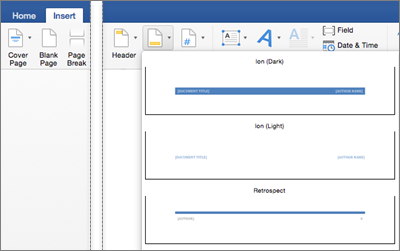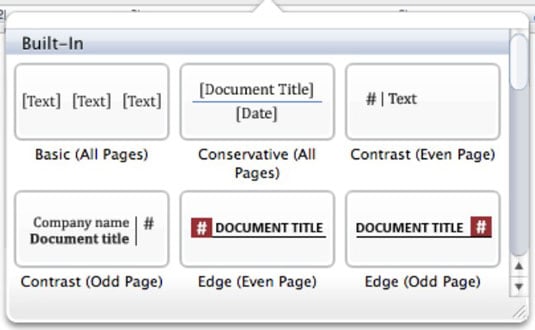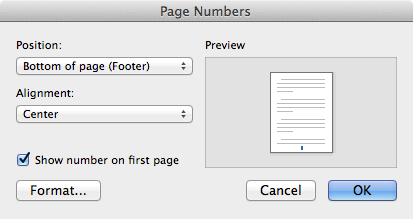Customize the document headers and footers in Word 2011 for Mac to show page numbers, dates, and logos for formal stationery. You can work with headers and footers in several of Word 2011’s views. The quick way to work with headers and footers is by way of the Header and Footer group on the Office 2011 Ribbon’s Document Elements tab.
Footer In Word 2010
Clicking either the Header or Footer button displays a gallery from which you can choose a style for your header or footer. The basic layout of three positions (left, center, and right) is the first style on the palette. Notice that some styles affect only odd-numbered or even-numbered pages. Some of the styles apply tables to the header or footer, so if you click into one of these styles, the Format Tables tab on the Ribbon will activate.
When you choose a header or footer style, Word changes the interface so that you can type in your header or footer. You can display this view by choosing View→Header and Footerwithout having to choose a style from the Ribbon. To work with the interface, simply click into it and type. Click the Page # button on the Ribbon to display the Page Numbers dialog, which you can use to choose alignment and formatting options for your page numbers.
Some documents need the same information, such as your name, address, phone and fax numbers, and e-mail address, to appear on every page. You can place this information as headers or footers in Word for Mac documents. Headers or footers will appear on every page of a document. Add and remove headers and footers in Pages on Mac. You can add headers and footers—fields at the top and bottom of a page that can include text, images, page numbers, the page count, and the date and time—to your document and then set where you want them to appear. You may need to edit for better formatting. For more info, see Add page numbers to a header or footer in Word. To change the font, color or size Select the text to change then go to Home and choose the options you want from the Font section. To add an image to a header or footer See Add images to a header or footer.
To exit Header and Footer view, choose a view from the views listed in the topmost group of the View menu, or double-click the document body. You can also click the small Close button below the Header or above the Footer area.

Section.Footers property (Word); 2 minutes to read; In this article. Returns a HeadersFooters collection that represents the footers in the specified section. Expression A variable that represents a 'Section' object. For information about returning a single member of a collection, see Returning an object from a collection. Customize the document headers and footers in Word 2011 for Mac to show page numbers, dates, and logos for formal stationery. You can work with headers and footers in several of Word 2011’s views. The quick way to work with headers and footers is by way of the Header and Footer group on the Office 2011 Ribbon’s Document Elements tab.



You may want to format your Header or Footer to display Page # of #. To make this custom format starting without a Header or Footer style, do the following:
Choose View→Header and Footer from the menu bar.
Click within either the Header or Footer area.
Your cursor will be at the left. Press Tab once or twice to move to the center or right, if desired.
Type the word “Page,” followed by a space.
Choose Insert→Field from the menu bar.
Make sure that Categories is set to (All). Under Field names, choose Page and then click OK.
Add a space and then type of followed by another space.
Choose Insert→Field from the menu bar.
Under Field Names, choose NumPages and then click OK.
If you are writing a report or thesis, you may need a different footer on every page or a series of pages. This tip shows you how to create different footers within your document.
You probably already know you can easily change the first page footer, or create different odd and even page footers, by selecting check boxes. These settings are found in the ribbon on the Header and Footer Design Tools tab. (Click inside the footer to show this tab.)
But what if you want to have a different footer for every chapter of your book or section of a term paper?
This isn’t as easy as selecting a check box, but it can be done without too much difficulty.
It is accomplished by creating a new section, then disconnecting the link between the footers. In Microsoft Word, by default, all footers in a document are connected. That connection has to be broken so you can create multiple footers without overwriting the previous ones.
To create a new section and disconnect the footers, follow these steps:
- Insert your cursor at the bottom of the last page of the previous chapter or section. (Make sure the cursor is outside of the footer area.)
- On the ribbon, select the Page Layout tab.
- In the Page Setup group, click Breaks, then under Section Breaks, select Next Page.
- The cursor jumps to the next page (or creates a new page if there is no next page). Remove any extra line breaks created. Be careful not to delete the section break (you can see it by pressing Ctrl+*).
- Go to the bottom of the first page of the new section and double-click inside the footer. This activates the Header & Footer Tools tab on the ribbon.
- On the Header & Footer Tools tab, in the Navigation group, click Link to Previous to deselect it. (If button is shaded yellow it is selected. If it is shaded white, it is deselected.)
Now you can create a new footer on this page. Repeat this process for each section of your document.

This is the same method used to format page numbers using different styles for front matter, main body, and appendices in a document.
How Do I Remove Headers And Footers In Word For Mac
More Word Tips:
